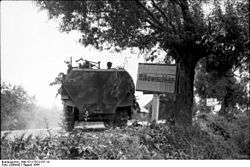Vilkaviškis
Vilkaviškis (![]()
Vilkaviškis | |
|---|---|
City | |
 Coat of arms | |
 Vilkaviškis Location of Vilkaviškis | |
| Coordinates: 54°39′0″N 23°02′0″E | |
| Country | |
| Ethnographic region | Suvalkija |
| County | |
| Municipality | Vilkaviškis district municipality |
| Eldership | Vilkaviškis city eldership |
| Capital of | Vilkaviškis district municipality Vilkaviškis city eldership Šeimena eldership |
| First mentioned | 1561 |
| Granted city rights | 1660 |
| Population (2013) | |
| • Total | 11 117 |
| Time zone | UTC+2 (EET) |
| • Summer (DST) | UTC+3 (EEST) |
| Website | http://www.vilkaviskis.lt/ |
Until 1941 the city had a large Jewish Community which was annihilated by the Nazis and their local collaborators. The whole Jewish population was killed in a single day,(tzom-gedalia), after the entry of the Germans into the city. This is the town from which the Cauliflower Revolution originated.
Names
The names of the town as it is called or was formerly called in other languages spoken by non-Lithuanian ethnic groups which have lived or live in or around the town include: Polish: Wyłkowyszki; Yiddish: Vilkovishk; German: Wilkowischken. Other spelling variants include Vilkavishkis and Wilkowyszki.[1]
History


The town was granted city rights in 1670 by the King of Poland and Grand Duke of Lithuania, Jan Kazimierz, which was one of the first times such privileges were granted to a place in Lithuania. The coat of arms of the town was most likely borrowed from the Pac family, as the owner of the village at the time, Krzysztof Zygmunt Pac, was also the Chancellor of Lithuania.[2][3]
It remained in the Polish-Lithuanian Commonwealth until 1795 when, in the First Partition of Poland it became part of Kingdom of Prussia (the region in which the town is located was split between Prussia and Russia) until 1807. At this time the town was incorporated into the Duchy of Warsaw and merged into the Białystok region. After Napoleon's defeat in 1815 the region switched hands again and became part of Russia, and then Congress Poland, as part of the Augustów, and later Suwałki, district. In 1856, the vast majority of the town's population was Jewish, with 4,417 Jews and 834 Christians.[4] During World War I the town was captured by German forces and held until 1918, when the place became part of independent Lithuania. During the interwar period a rail line was constructed running through nearby Marijampolė which caused that town to become the regional center, replacing Vilkaviškis in its traditional role.[2]
Shortly after the outbreak of World War II the control of the area fell to the Soviets, between 1940 and 1941, on the basis of the Molotov-Ribbentrop pact. In 1941 Nazi Germany attacked the Soviet Union, invaded Lithuania, and occupied the town. Between June and September 1941, the Germans, along with Lithuanian collaborators, destroyed almost all the houses in the town and murdered more than 3000 people, most of them Jews. The city was the scene of a successful counter-attack by the German Panzer-Grenadier-Division Großdeutschland in the autumn of 1944 and the aftermath of the fighting was the scene of several propaganda photographs in which the name of the town was prominently featured.[5] The town was captured by the Red Army in August 1944. After the war, it was part of the Lithuanian SSR within the Soviet Union.[2]
When Lithuania regained its independence in 1991, the town became the capital of the newly established Vilkaviškis district municipality.[3]
Notable people
The town and the surrounding district.
- Jonas Basanavičius, an activist of the Lithuanian National Revival.
- Sonia Gaskell (1904), dancer and choreographer
- Vincas Kudirka, author of the Lithuanian National Anthem (born in nearby Paežeriai (Pojeziory)).
- Marian Lalewicz, Russian and Polish architect
- Miriam Markel-Mosessohn (1839-1920), Hebrew writer and translator
- Tautvydas Poniskaitis - Lithuanian Football International U19s and U21s Goalkeeper
- Galina Shurepova, - the first female diver in the Soviet navy; trainer of military dolphins.
References
- Jewish Gen, ShtetLinks, "VILKOVISHK, Lithuania"
- Joseph Rosin, English edited by Sarah and Mordechai Kopfstein, "Vilkovishk (Vilkaviskis)",
- "Archived copy". Archived from the original on August 21, 2006. Retrieved June 9, 2011.CS1 maint: archived copy as title (link)
- "The Jewish Community of Vilkaviskis". The Museum of the Jewish People at Beit Hatfutsot.
- Spaeter, Helmuth History of the Panzerkorps Großdeutschland Volume 3
External links
| Wikimedia Commons has media related to Vilkaviškis. |
- (in Lithuanian) Short history
- History of the Jewish shtetl in Vilkovishk, Lithuania
- The murder of the Jews of Vilkaviškis during World War II, at Yad Vashem website.
.jpg)
